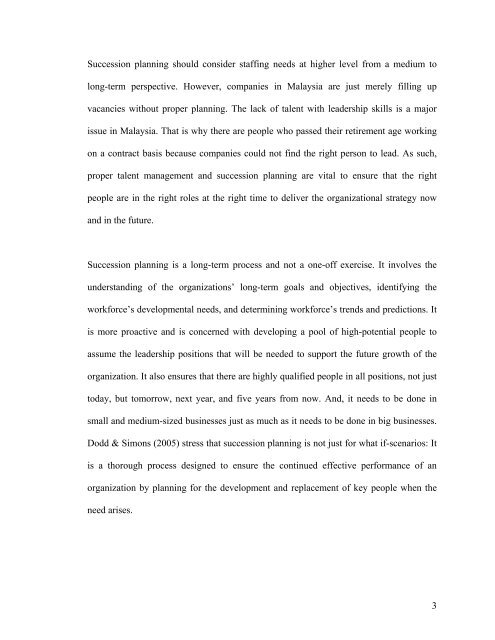CHAPTER 1: INTRODUCTION 1.0 Chapter Overview - DSpace@UM
CHAPTER 1: INTRODUCTION 1.0 Chapter Overview - DSpace@UM
CHAPTER 1: INTRODUCTION 1.0 Chapter Overview - DSpace@UM
Create successful ePaper yourself
Turn your PDF publications into a flip-book with our unique Google optimized e-Paper software.
Succession planning should consider staffing needs at higher level from a medium tolong-term perspective. However, companies in Malaysia are just merely filling upvacancies without proper planning. The lack of talent with leadership skills is a majorissue in Malaysia. That is why there are people who passed their retirement age workingon a contract basis because companies could not find the right person to lead. As such,proper talent management and succession planning are vital to ensure that the rightpeople are in the right roles at the right time to deliver the organizational strategy nowand in the future.Succession planning is a long-term process and not a one-off exercise. It involves theunderstanding of the organizations’ long-term goals and objectives, identifying theworkforce’s developmental needs, and determining workforce’s trends and predictions. Itis more proactive and is concerned with developing a pool of high-potential people toassume the leadership positions that will be needed to support the future growth of theorganization. It also ensures that there are highly qualified people in all positions, not justtoday, but tomorrow, next year, and five years from now. And, it needs to be done insmall and medium-sized businesses just as much as it needs to be done in big businesses.Dodd & Simons (2005) stress that succession planning is not just for what if-scenarios: Itis a thorough process designed to ensure the continued effective performance of anorganization by planning for the development and replacement of key people when theneed arises.3
















